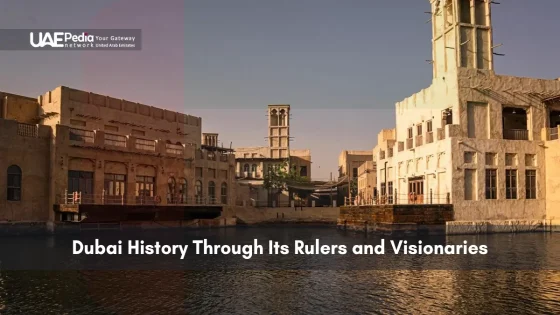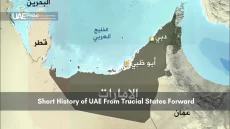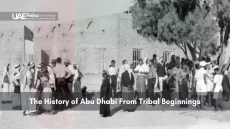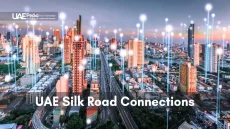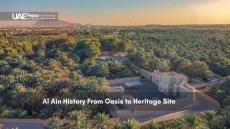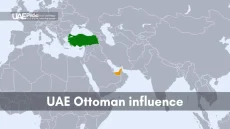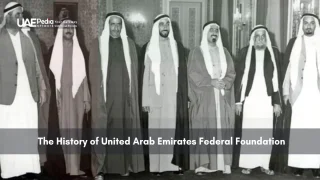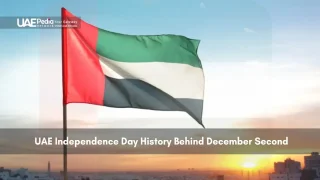What if we told you Dubai’s origin story began long before oil rigs dotted the landscape? Venetian merchant Gasparo Balbi’s 16th-century writings reveal a bustling pearling hub where dhows sailed toward India – a far cry from today’s glass towers, yet equally ambitious.
This desert jewel in the United Arab Emirates grew from humble roots. Early Arab geographers like Muhammad al-Idrisi documented its strategic position along spice routes, while Bedouin tribes forged alliances that shaped governance. The city’s DNA still carries traces of frankincense traders and pearl divers who first connected it to the world.
What makes this emirate unique isn’t just its rapid modernization, but how it honors its past. You’ll find wind-tower architecture beside AI-powered metros, and souks echoing with languages once spoken on merchant ships. Abu Dhabi’s rise as a capital hasn’t dimmed the coastal charm that first put this region on ancient maps.
Key threads we’ll unravel:
- How 12th-century texts foreshadowed the United Arab Emirates’ global mindset
- The role of monsoon winds in shaping early cultural exchanges
- Why pearl diving traditions still influence the city’s entrepreneurial spirit
Origins and Early Influences of the Region
The roots of this thriving area stretch back to a time when pearls were more valuable than oil. Archaeologists uncovered stone tools and pottery shards revealing human activity here as early as 7000 BCE – proof that ancient communities mastered desert survival long before modern innovations.
Prehistoric Settlement and Agricultural Beginnings
Imagine date palms swaying where skyscrapers stand today. Early inhabitants transformed this arid landscape through clever irrigation systems, cultivating crops that sustained growing communities. Coastal shifts around 3000 BCE created fertile grounds for trade, while Bedouin tribes developed water-sharing practices still honored in Emirati culture.
Cultural Exchanges and Early Trade Routes
Sixth-century caravan stations like Jumeirah became pit stops for merchants hauling frankincense to Mesopotamia. Monsoon winds carried dhows laden with pearls to India, creating an early trade network that shaped the area’s economy. These exchanges left their mark – bronze coins from Persia, pottery from China, and storytelling traditions blending desert wisdom with seafaring lore.
Three key elements defined the emirate’s ancient DNA:
- Resilience: Adapting farming techniques to shifting sands
- Connection: Bridging land and sea trade routes
- Community: Shared water resources fostering social bonds
By the 3rd century CE, pearling crews worked Gulf waters using techniques passed through generations – a blueprint for the entrepreneurial spirit that would later redefine this emirate.
The Emergence of a Strategic Trading Hub
Imagine diving into turquoise waters where fortunes were once pulled from the seafloor. By the 18th century, over 1,200 pearling boats dotted the Persian Gulf, their crews mastering techniques refined across generations. This aquatic gold rush built the foundation for what would become one of the world’s busiest ports.
Pearling Industry and Maritime Legacy
At its peak, pearling employed nearly a third of the local population. Divers free-dove 30 meters on single breaths, harvesting oysters that adorned European royalty. The industry’s collapse in the 1930s forced reinvention – but its spirit lived on in daring trade ventures.
| Era | Key Export | Economic Impact |
|---|---|---|
| 1700s-1930s | Natural Pearls | 90% of regional income |
| 1950s-present | Re-Exported Goods | 35% of GDP (2023) |
British Influence and the Trucial States Era
When British ships arrived seeking safe harbors, savvy leaders negotiated the 1835 Maritime Truce. This pact transformed the coast into a protected trade corridor. By 1892, the Trucial States agreement formalized partnerships that modernized port operations and governance.
Infrastructure blossomed under these alliances. Dredged harbors welcomed larger vessels, while new roads connected markets. Early tourism initiatives in the 1960s saw visitors arriving by sea, their cameras capturing dhow races alongside emerging skylines.
Three lasting legacies from this era:
- Customs systems balancing tradition with global needs
- Coastal defenses ensuring safe passage
- Trade policies encouraging foreign investment
dubai history: Rulers and Governance through the Centuries
Picture a desert council where decisions shaped skylines. Long before cranes dotted the horizon, leaders like Maktoum bin Butti Al Maktoum forged alliances under woven tents. Their choices still echo in the emirates’ bustling souks and boardrooms alike.
The Al Maktoum Dynasty and Early Leadership
When Maktoum bin Butti arrived in 1833, he didn’t just claim land—he built trust. Tribal leaders gathered in majlis sessions, debating water rights and trade routes. This open-door approach transformed a fishing village into a hub where Bedouin traditions met global ambitions.
By 1892, nearly 60% of the population engaged directly in governance through local councils. Fishermen voiced concerns alongside pearl merchants, creating policies that balanced growth with cultural preservation. The rulers’ genius? Treating every voice as mortar in the emirate’s foundation.
Key Treaties and Political Shifts
The 1892 Exclusive Agreement with Britain wasn’t just paperwork—it reshaped daily life. Customs duties dropped by 15%, attracting traders from Bombay to Bahrain. Yet leaders safeguarded autonomy, ensuring foreign partnerships strengthened rather than overshadowed local identity.
Three pillars sustained transitions through time:
- Adaptive laws protecting both camel caravans and cargo ships
- Infrastructure projects employing 40% of working-age people by 1900
- Education reforms preparing youth for roles beyond traditional trades
Walk through downtown today, and you’ll spot the legacy—construction projects mirroring ancestral irrigation designs, government towers shaped like ancient watchtowers. The rulers’ blend of foresight and flexibility turned survival strategies into blueprints for modernity.
Modern Transformation: From Oil Discovery to Global Trade
Beneath shifting sands lay more than pearls—liquid gold sparked a metamorphosis that rewrote a coastline’s destiny. When drillers struck oil in 1966, visionary leaders funneled resources into building bridges to the future while honoring ancestral ties to the coast.
Economic Boom and Infrastructure Development
The first oil shipment in 1969 funded game-changers like Port Rashid (1972). Within a decade, cargo tonnage skyrocketed 400%. Desert highways replaced camel tracks, and Jebel Ali Free Zone lured global firms with tax incentives. By 1985, over 1,200 companies called this capital of commerce home.
Evolution of Urban Planning
Urban planners faced a puzzle: How to erect skylines without erasing heritage? Their answer? Palm-shaped islands echoing dhow sails, and glass towers mimicking wind towers. The Burj Khalifa’s 828-meter spire—completed in 2010—became more than a building. It symbolized relentless growth.
| Era | Key Industry | Contribution to GDP |
|---|---|---|
| Pre-1966 | Fishing & Pearling | 75% |
| 1970-1999 | Oil & Construction | 68% |
| 2000-Present | Trade & Tourism | 83% |
From Nets to Networks
Traditional fishing villages transformed into tech hubs, but didn’t vanish. Al Shindagha Museum now stands where nets once dried, while dhow docks host sunset cruises. This coast still thrives on connection—just swap pearls for fiber-optic cables.
Last year alone, the emirate welcomed 16 million visitors. Yet walk the Creek’s edge at dawn, and you’ll spot fishermen casting nets as their ancestors did—a living mosaic where every year layers new dreams upon old rhythms.
Visionary Leadership and Future Prospects
What if skyscrapers could grow like desert palms? The Maktoum family’s blueprint turns this metaphor into steel and glass. Sheikh Mohammed bin Rashid Al Maktoum’s team recently unveiled plans for a solar-powered vertical farm shaped like a date palm—proof that ambition still blooms where pearls once traded.
Innovative Projects and Global Partnerships
The Burj Khalifa isn’t just tall—it’s a compass pointing upward. Since its 2010 debut, this icon has anchored partnerships with firms from Seoul to Silicon Valley. Last year’s AI-powered city management system, developed with IBM, slashed energy use by 25% across 50+ towers.
Three game-changers redefining growth:
- Expo 2020’s legacy: 80% of its infrastructure now hosts green tech startups
- Hyperloop prototypes cutting Abu Dhabi-Dubai travel to 12 minutes
- Maktoum bin Butti’s majlis diplomacy reborn as investor summits
Sustainability, Technology, and Space Initiatives
Mars isn’t the limit anymore. The Mohammed bin Rashid Space Centre’s lunar rover project partners with Japan’s ispace—while Earth-side, solar farms mimic 20th century pearl divers’ navigation patterns. Even the Trucial States’ trade routes get a cosmic twist: Emirates Mars Mission data now guides climate solutions across 17 nations.
“We build towers not to touch clouds, but to lift horizons.”
Oil discovery taught resilience; today’s visionaries convert it into renewable grit. The same waters that carried pearl dhows now test tidal energy turbines. From Bedouin star navigation to AI-driven metro systems, every leap forward remembers its first step.
Legacy, Impact, and the Road Ahead
From creek-side trading post to world tallest towers, this emirate’s story unfolds like a dhow catching the wind. We marvel at how fishing nets evolved into fiber-optic networks while Dubai Creek still pulses with life – a liquid thread connecting pearl divers’ grit to today’s global ambitions.
Visionary leadership transformed the region through bold partnerships. When the emirate joined the UAE in 1971, it sparked collaborations now visible in Dubai International’s flight paths and solar-powered smart cities. Landmarks whisper dual truths: futuristic towers mirror ancient irrigation patterns, and AI metros hum beside spice-scented souks.
The roadmap ahead? It’s written in sustainable concrete and starlight. Space initiatives build on ancestral navigation skills, while mangrove restoration projects honor the country’s coastal roots. Challenges become opportunities here – just as desert sands once birthed pearls.
Walk the Dubai Creek shores at sunset. You’ll spot abra boats ferrying dreamers past skylines where every glass pane reflects both tomorrow’s promise and yesterday’s wisdom. This region doesn’t just adapt to change – it sculpts it, one daring vision at a time.
Coastal settlements thrived as crossroads between Mesopotamia, Indus Valley, and Oman. Dhows carried spices, textiles, and pearls—linking Bedouin traditions with global markets. This exchange laid foundations for the Emirates’ knack for connectivity.
Pearling fueled the economy for centuries, employing divers and traders. When Japanese cultured pearls emerged in the 1930s, it sparked a crisis—pushing leaders like Sheikh Saeed Al Maktoum to innovate, foreshadowing today’s adaptive spirit.
Since 1833, the Al Maktoums prioritized trade, stability, and diplomacy. Sheikh Rashid bin Saeed’s 1958 modernization pact with the British set Dubai’s “build it first” ethos—think Port Rashid and airport expansions before oil wealth arrived.
Oil discovery in 1966 funded infrastructure, but leaders doubled down on diversification. Free zones, Emirates Airlines, and Jebel Ali Port turned sand into global gateways—proving vision matters more than black gold alone.
From solar-powered Masdar City to mangrove conservation, the UAE balances ambition with eco-smarts. Even Burj Khalifa’s cooling systems reuse water—a nod to ancestral desert survival hacks meeting AI-driven green tech.
